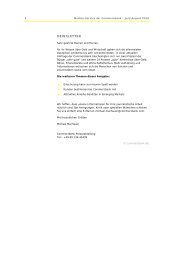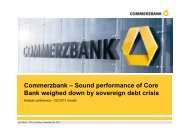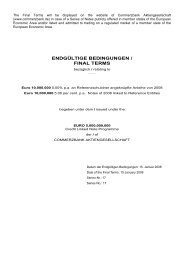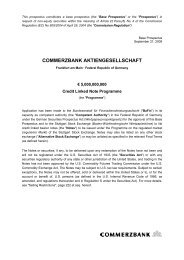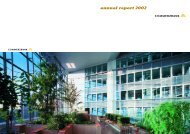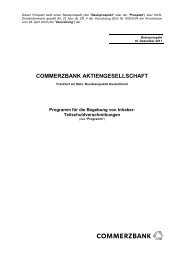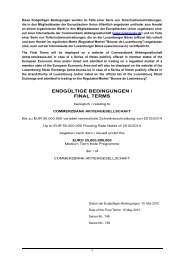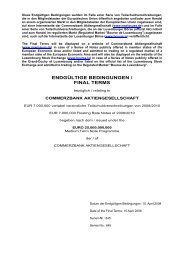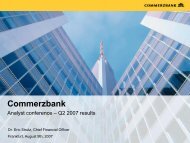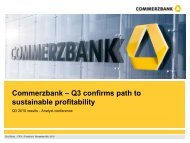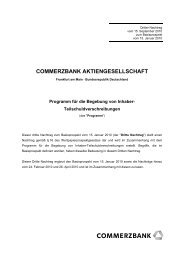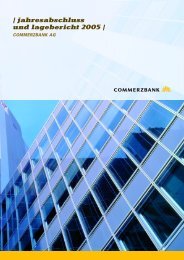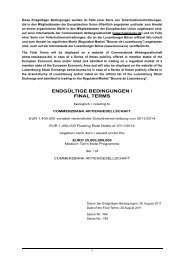COMMERZBANK AKTIENGESELLSCHAFT
COMMERZBANK AKTIENGESELLSCHAFT
COMMERZBANK AKTIENGESELLSCHAFT
Create successful ePaper yourself
Turn your PDF publications into a flip-book with our unique Google optimized e-Paper software.
Group Financial Statements<br />
300<br />
244 Commerzbank Annual Report 2011<br />
• The Portfolio Restructuring Unit (PRU) is responsible for<br />
managing down assets related to proprietary trading and<br />
investment activities which no longer fit into Commerzbank’s<br />
client-centric strategy and were discontinued in 2009. The<br />
segment’s goal is to reduce the portfolio in a way that<br />
optimises the bank’s capital position. The positions managed<br />
by this segment initially included asset-backed securities<br />
(ABSs) which do not have a state guarantee, other structured<br />
credit products, proprietary trading positions in corporate or<br />
financial bonds and exotic credit derivatives. These positions<br />
were primarily transferred from the Corporates & Markets and<br />
former Commercial Real Estate segments to the Portfolio<br />
Restructuring Unit.<br />
• The Others and Consolidation segment contains the income<br />
and expenses which are not attributable to the operational<br />
business segments. The Others category within this segment<br />
includes equity holdings which are not assigned to the<br />
operating segments as well as Group Treasury. The costs of<br />
the service units which – except for integration and<br />
restructuring costs – are charged in full to the segments are<br />
also shown here. Consolidation includes expense and income<br />
items that represent the reconciliation of internal<br />
management reporting figures shown in segment reporting<br />
with the consolidated financial statements in accordance with<br />
IFRS. The costs of the Group management units which are<br />
charged in full to the segments, except for integration and<br />
restructuring costs, are also reported under this heading.<br />
The performance of each segment is measured in terms of<br />
operating profit or loss and pre-tax profit or loss, as well as<br />
return on equity and the cost/income ratio. Operating profit or<br />
loss is defined as the sum of net interest income after loan loss<br />
provisions, net commission income, net trading income and net<br />
income from hedge accounting, net investment income, current<br />
net income from companies accounted for using the equity<br />
method and other net income less operating expenses. As we<br />
report pre-tax profits, non-controlling interests are included in<br />
the figures for both profit or loss and average capital employed.<br />
All the revenue for which a segment is responsible is thus<br />
reflected in the pre-tax profit.<br />
The return on equity is calculated as the ratio of profit (both<br />
operating and pre-tax) to average capital employed. It shows the<br />
return on the capital employed in a given segment. The<br />
operating cost/income ratio reflects the cost efficiency of the<br />
various segments and shows the relationship of operating<br />
expenses to income before provisions.<br />
Income and expenses are reported in the segments by<br />
originating unit and at market prices, with the market interest<br />
rate method being used for interest rate operations. The actual<br />
funding costs for the segment-specific equity holdings allocated<br />
to each segment are shown in net interest income. The Group’s<br />
return on capital employed is allocated to the net interest<br />
income of the various segments in proportion to the average<br />
capital employed in the segment. The interest rate used is the<br />
long-term risk-free rate on the capital market. The average<br />
capital employed was calculated using the Basel II methodology,<br />
based on the computed average risk-weighted assets and the<br />
capital charges for market risk positions (risk-weighted asset<br />
equivalents). At Group level, investors’ capital is shown, which is<br />
used to calculate the return on equity. The regulatory capital<br />
requirement for risk-weighted assets assumed for segment<br />
reporting purposes is 7%.<br />
The segment reporting of the Commerzbank Group shows<br />
the segments’ pre-tax profit or loss. To adjust for the impact on<br />
earnings of specific tax-related transactions in the<br />
Corporates & Markets segment, the net interest income of<br />
Corporates & Markets includes a pre-tax equivalent of the aftertax<br />
income from these transactions. When segment reporting is<br />
reconciled with the figures from external accounting this pre-tax<br />
equivalent is eliminated in Others and Consolidation.<br />
The carrying amounts of companies accounted for using the<br />
equity method were €694m (previous year: €737m) and are<br />
divided over the segments as follows: Private Customers €278m<br />
(previous year: €224m), Mittelstandsbank €96m (previous year:<br />
€95m), Corporates & Markets €85m (previous year: €33m),<br />
Asset Based Finance €154m (previous year: €320m) and Others<br />
and Consolidation €81m (previous year: €65m).<br />
The operating expenses reported under operating profit or<br />
loss contain personnel expenses, other operating expenses as<br />
well as depreciation and write-downs on fixed assets and other<br />
intangible assets. Restructuring expenses are reported below the<br />
operating profit line in pre-tax profit or loss. Operating expenses<br />
are attributed to the individual segments on the basis of cost<br />
causation. The indirect expenses arising in connection with<br />
internal services are charged to the user of the service and<br />
credited to the segment performing the service. The provision of<br />
intra-group services is charged at market prices or at full cost.



